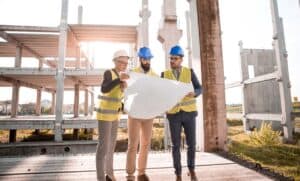Key Takeaways:
- Sustainable construction is gaining momentum due to its environmental and economic benefits.
- Using eco-friendly materials and techniques can significantly reduce a building’s carbon footprint.
- Integrating technology, such as intelligent systems, enhances the efficiency of sustainable projects.
- Collaborating with professionals who understand sustainable practices is crucial for project success.
The Rise of Sustainable Construction
In recent years, eco-friendly building has become a movement and a crucial change in the construction sector. The focus is on minimizing environmental harm while fulfilling current needs without jeopardizing the capacity of future generations to satisfy their own needs. This holistic approach involves the thoughtful integration of economic, social, and environmental interests, creating resource-efficient and environmentally responsible structures.
The impact of sustainable construction is profound. By significantly reducing carbon emissions through energy-efficient design and construction practices, the industry contributes positively to global efforts against climate change. Moreover, with the growing demand for green buildings, there is an increased focus on minimizing waste and utilizing renewable and recyclable materials throughout construction.
Why Choose Sustainable Materials?
The selection of materials plays a pivotal role in sustainable construction. Eco-friendly materials such as recycled metals, reclaimed wood, and innovative alternatives like bamboo offer significant environmental benefits. With environmental issues becoming increasingly urgent, companies like Snyder Construction are embracing eco-friendly strategies in their projects. These materials reduce dependence on non-renewable resources, lower construction costs, and enhance the structure’s durability. Moreover, they contribute to a building’s lifecycle, improving its sustainability footprint from cradle to grave.
Using sustainable materials is a practical approach to reducing environmental impact and supports broader sustainability goals, such as waste reduction. These materials often possess higher durability and require less maintenance, which translates into lower costs in the long run, enhancing the financial viability of sustainable projects.
Innovative Technologies in Construction
Smart technologies have brought a transformative shift in sustainable construction practices. Technologies like energy-efficient and automated building management systems are essential for optimizing energy consumption. For example, recent innovations in energy management systems allow precise control over climate settings within buildings, significantly enhancing energy efficiency and reducing emissions.
Moreover, these technologies facilitate the integration of renewable energy sources, such as solar and wind, into building designs. They allow for intelligent energy usage adjustments based on real-time data, maximizing efficiency. The widespread adoption of such technologies in modern construction enhances sustainability and leads to significant cost savings over time.
Designing for the Environment
Environmental design is another crucial aspect of sustainable construction. By considering the specific ecological contexts during project planning, buildings can be designed to blend naturally with their surroundings. This approach leverages the natural environment, using passive solar design and natural ventilation to reduce energy consumption and increase efficiency.
Strategically placing windows for maximum daylight usage or designing roofs to support rainwater harvesting are examples of how sustainable buildings can utilize local environmental factors. Such designs reduce the reliance on artificial energy sources and enhance the quality of life for building occupants.
Economic Benefits of Sustainable Projects
Erecting sustainable buildings presents significant economic advantages. Although they might initially require a higher investment, they often yield substantial savings in the long term. Cost reductions result from improved energy and water efficiency, reduced waste generation, and lower maintenance costs. Sustainable projects also often meet or surpass current building standards, earning additional financial advantages such as tax incentives or rebates.
Furthermore, these buildings tend to have higher valuation and resale rates as the demand for environmentally friendly homes and offices grows. Over time, the operational savings and added financial incentives outweigh the initial investments, making them a smart economic choice.
Challenges in Implementing Sustainable Practices
Despite their numerous benefits, introducing sustainable practices is challenging isn’t. High initial costs, limited material availability, and key market knowledge gaps can deter builders and developers. However, with consistent demand and regulatory encouragement, industry costs are expected to decrease, making sustainable practices more accessible.
Furthermore, education and training initiatives can equip stakeholders with the necessary skills and knowledge to implement sustainable practices successfully, enhancing overall industry capability and resilience.
The Role of Collaboration in Sustainable Construction
Collaboration is essential for the success of sustainable construction projects. Teams comprising architects, engineers, scientists, and environmental specialists can effectively address these projects’ multifaceted challenges. Such interdisciplinary cooperation fosters innovation, ensuring that every aspect of the project is examined through a sustainability lens.
The shared insights and collaborative solutions generated from diverse perspectives drive the project toward its environmental goals and create efficient, durable, and aesthetically pleasing structures.
Future Trends in Sustainable Construction
The outlook for sustainable construction is exciting, with numerous developments on the horizon. Innovations in materials, construction methods, and design principles continue to reshape the industry. Emerging trends include exploring advanced materials, biodegradable options, and carbon-neutral technologies.
These advancements make sustainable construction practices more feasible and comprehensive, indicating a positive trajectory for an industry increasingly dedicated to sustainability and environmental stewardship.

